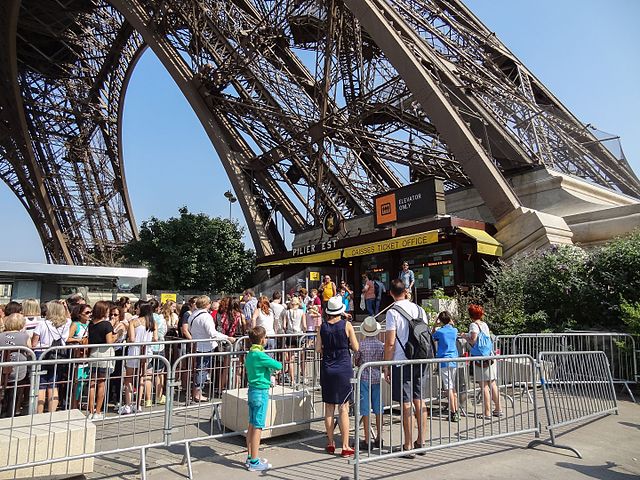Top 10 Interesting Facts About Bastille Day
Have you ever been in France on July 14th and wondered what all the fireworks were about? Well, you were amongst the celebrations organized for France’s national day! Here is the top ten interesting facts about Bastille Day.
Fact n°1: It is not actually called Bastille Day
The first thing an English-speaker should know is that there is a great chance that a French person would not understand what “Bastille Day” refers to, if it were to be mentioned. Indeed, in France, everybody calls it “le 14 juillet” – July 14th – or simply “la fête nationale” – National Day. That said, the Bastille does have something to do with it.
Fact n°2: It all started with the Storming of la Bastille…

“Storming of the Bastille, July 14, 1789”, Anonymous. Sourced from Wikipedia.
Let’s go back to the kingdom of France under Louis XVIth’s rule. Discontent among the population had grown stronger and stronger over the years due to economic difficulties, combined with a rising criticism towards absolute monarchy. It all eventually exploded in 1789.
In May, the king had to summon the General Estates in order to address the realm’s financial deficit, created by the help given to the American Revolution. The General Estates were an assembly composed of representatives of the Clergy, the Nobility and the Commoners. The latter, also called the “Third Estate”, ended up gathering together in late June, calling themselves a “National Assembly” and vowing never to dissolve before having granted the country with a new constitution.
Fast forward to the week leading to July 14th, when the atmosphere started to get very tense in Paris. The people rioted to denounce the price of bread rising and attacked tax collectors. Fearing repression from the army surrounding the city on the king’s orders, they started to steal weapons in order to defend themselves and the Constituent Assembly. After managing to take hold of cannons and rifles, all they needed was powder and bullets. Guess which building had plenty?
On the morning of July 14th, which happened to register the highest price of bread since the beginning of Louis XVI’s reign, a delegation of Parisians negotiated with the Bastille’s governor so that he would hand over the arsenal. By midday, no progress had been made through pacific means, so the crowd of Parisians started to resort to force. A battle ensued between the insurgents and the soldiers protecting the Bastille. At the end of the day, the governor eventually surrendered and the rioters took over the building.
Fact n°3: July 14th, 1789, was more of a symbolic event than a remarkable feat of arms
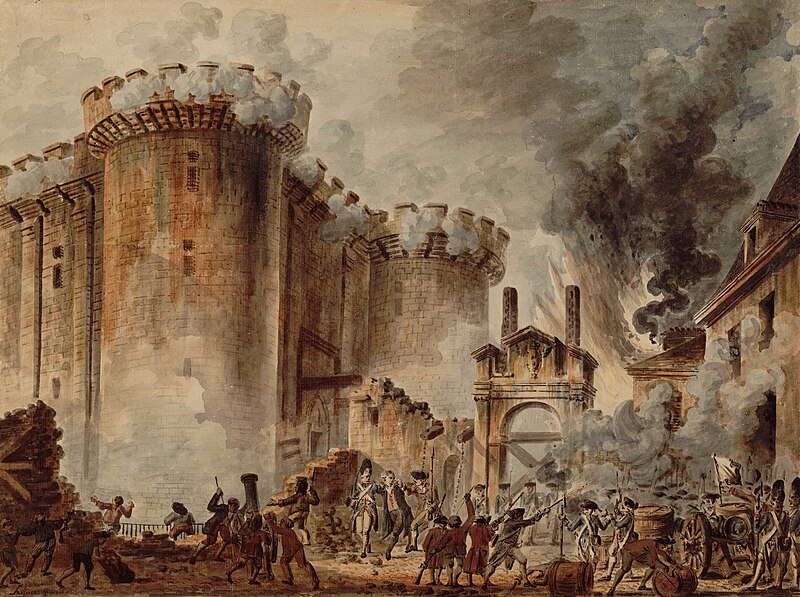
“The Storming of the Bastille”, Jean-Pierre Hoüel, 1789. Sourced from Wikipedia.
At this point, you may be wondering why would the French turn such an event into their National Day. Well, to understand its impact at the time, one has to recall the symbol the Bastille represented. The Bastille was a fortress built in the XIVth century by King Charles V. It was meant to defend Paris’ borders, but also to protect the monarch in case of a popular insurrection, since it was on the path between his main residence, the Vincennes Castle, and his Parisian one.
Over the centuries, the fortress also served as a safe for the royal treasure. But most importantly, ever since the XVth century, kings frequently used the building as a prison. Under Louis XIV, the Bastille officially became a State’s prison, where the king’s enemies and critics would be locked up. Voltaire and the Marquis de Sade were among the most famous royal prisoners held in the Bastille.
From that point on, several books contributed to depict the Bastille as an awful place where people would be imprisoned without trial, tortured and killed. Therefore, a long history made the Bastille the symbol of monarchical power, as well as the embodiment of royal tyranny in people’s minds.
That is why, at the time, everybody – the Parisians, the king, the nobility –, everywhere – in France or in the neighboring royal courts – understood the meaning when it was surrendered to and taken over by the people. The insurgents even set free the few prisoners held in its walls. The Storming of the Bastille thus remains one of the most important symbols of the French Revolution, as well as one of the first events leading to the fall of monarchy and the rise of the Republic.
Fact n°4: The French National Day actually commemorates both July 14th, 1789 and July 14th, 1790!
Before you think you’ve seen the last of Bastille Day’s history, hang on because it only gets more interesting and bizarre from here on. A less commonly known fact, even among French people, is that it does not only commemorate July 14th, 1789, but also another event which occurred a year after: “la fête de la Fedération”.

“Fête de la Fédération”, Woodcut by Helman, picture by Monet, 1790. Sourced from Wikipedia.
This “Festival of the Federation” consisted in a huge civil ceremony meant to celebrate national unity for the Storming of the Bastille’s first birthday. The idea came from none other than the marquis de La Fayette, appointed by Louis XVI as the head of the National Guard of Paris. It is worth noting that we are still two years away from the king’s beheading. In 1790, France resembled a constitutional monarchy and the very purpose of the Festival was to secure this regime.
Picture the Champs-de-Mars – where the Eiffel Tower would be built a century after – with about 10,000 people witnessing a series of oaths to the Nation, the Constitution and the law. First, La Fayette did so in the name of the federated National Guards; then, the Assembly’s President did so in the name of the deputies; and finally, the king. A Te Deum followed. The event ended in a huge feast, with people dancing, singing, drinking and eating.
Fact n°5: July 14th became France’s National Day in 1880 as a compromise between Republicans and Royalists
If you are now confused as to why Bastille’s Day would commemorate a bloody attack against a symbol of monarchy on the one hand, and a festive event promoting constitutional monarchy on the other, then you are starting to understand what was at stake for the member of Parliament who defended this date as France’s National day a century after.
Indeed, it is only in 1880 that July 14th was officially adopted as such. Why? Because after a constant back and forth between monarchical and republican regimes (not to mention Napoleon‘s Consulate and Empire) during the majority of the XIXth century, France had just started by then its third Republic in 1870 and intended, this time, to make it last (spoiler alert: it did). It meant being able to compromise between royalist conservatives and staunch republicans.

Photo by Andre Gill on Wikimedia Commons
That is why, when the painter and deputy Benjamin Raspail suggested to turn July 14th into the national day, he did not clarify which year, in order to please at the same time those who would relate with the Storming of the Bastille and those who would with la fête de la Fédération. To this day, the law does not specify one date or another.
Fact n°6: Van Gogh depicted July 14th twice
Since 1880, the Republic has put on her best attire every year to celebrate July 14th: the red, white and blue flags, the Marseillaise, and the “Liberté, Egalité, Fraternité” – all symbols officially adopted during the third Republic, along with the national day’s date. The event obviously could not have been missed by the artists who lived in France and it actually inspired one of the greatest.
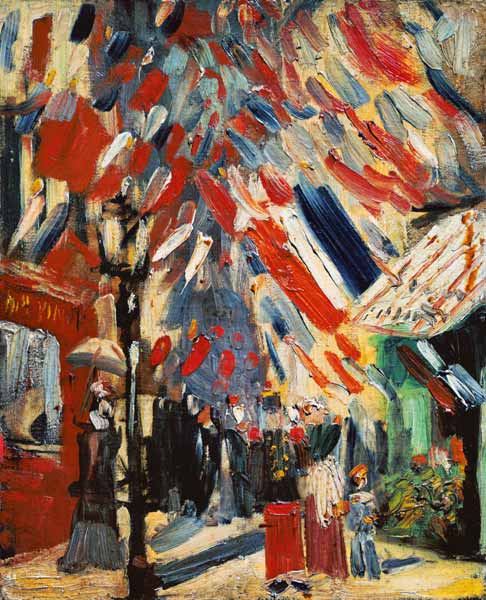
“14 juillet”, Vincent Van Gogh, 1886. Sourced from www.repro-tableaux.com.
Vincent Van Gogh indeed painted two pieces on the topic: the first in 1886, full of red, white and blue flags in an urban environment; and another in 1890 representing the city hall of Auvers-sur-l’Oise, where he was mentally treated by a doctor. In this one, the flags and garlands’ colors actually appear almost unnoticeable in the cool-toned painting, predominantly green and yellow, giving not so much of a festive impression. Was it representative of Van Gogh’s mood? Not long after he created this piece, he sadly shot himself and died from his injuries.

“La Mairie d’Auvers sur l’Oise le 14 juillet”, Van Gogh, 1890. Sourced from Wikipedia.
Fact n°7: July 14th always begins with a military parade

“The Patrouille de France passing by during the French national celebration of 2009”, Dimitri Torterat. Sourced from Wikipedia.
Since 1880, a military parade has been organized in the morning of July 14th. The French Republic showcases on this day its forces: be it policemen or soldiers, be them on foot, on horseback or in military vehicles. The Air Force is also represented since they pass over the parade, leaving in the sky great red, white and blue streaks behind them. It is worth noting that women working in the army or in the police had to wait 1971 to be allowed to partake in the parade.
For the first time, in 2015, the RAID, the GIGN and the BRI, all special forces of the National Police dedicated to dealing with crises and dangerous missions linked to criminality and terrorism, joined the parade after their intervention during the terrorist attacks led in January 2015 in the offices of Charlie Hebdo and in a kosher supermarket.
Frequently, the parade welcomes troops from an invited foreign army. For instance, in 2016, New Zealand was the guest of honor, so Maori warriors marched. In 2017, a century after the United States’s involvement in the First World War, President Trump came to see some of the American troops take part in the celebrations.
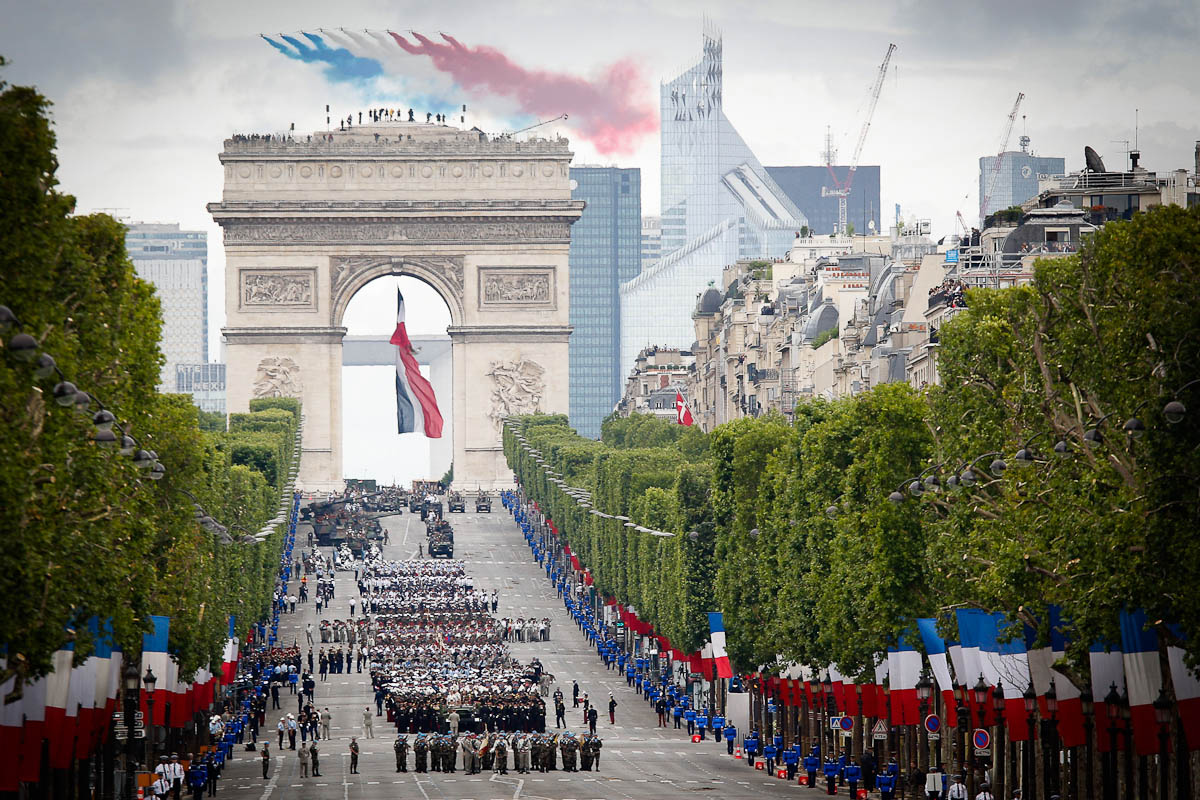
July 14th, 2012. ©Jean-Claude Coutausse
Fact n°8: The path followed by Bastille Day’s military parade changed according to the historical context

Postcard of Bastille Day in Longchamps Racecourse, circa 1909. Sourced from Wikipedia.
The military parade used to take place in the Longchamp Racecourse in the Bois de Boulogne, in Paris, but after the First World War, this changed. The parade then passed by the Champs-Elysées, notably stopping at the Arc de Triomphe, to pay a tribute in front of the Unknown Soldier’s tomb.
Between 1940 and 1944, when France was occupied by the Germans during the Second World War, there could obviously not be any celebration nor parade in the streets of Paris between 1940 and 1944. In London, though, French members of the Resistance would still march.
Nowadays, since 1981, the parade traditionally starts from the Champs-Elysées, up to the Arc de Triomphe, before joining the President, the government and the foreign ambassadors on the place de la Concorde.
Fact n°9: Many festivities are programmed on Bastille Day in Paris
If you wanted to live a Bastille Day in Paris like a French person, you would probably start in the morning by turning on the television to watch the military parade, or, simply, by going to the Champs-Elysée to see it in person. When this is done, the show continues at night. You may join theTrocadéro gardens to enjoy the most expected event of the day: the majestic, thirty-minute long firework show happening around the Eiffel Tower at 11pm. Afterwards, when your eyes are still sparkling from the beauty you witnessed, a big concert begins at the feet of the monument. Furthermore, if you prefer to go dancing with handsome firemen, balls are organized in every arrondissement’s fire station. Needless to say that this goes for everywhere else in France, where fireworks, concerts and balls can be found even in the smallest cities.
Fact n°10: Bastille Day fireworks happen everywhere in France, but here are some of the best ones
Looking for the best view over the fireworks in Paris? Here is a selection. First of all, the Sacré-Coeur, the Montparnasse Tower or even the Trocadero’s esplanade allows a clear view of the show, though these places will quickly get crowded, so you better come early! The Belvedère de Belleville, located in the charming Belleville‘s park in the 20th arrondissement, also provides a panoramic view of the fireworks. Another idea is to enjoy it from a boat floating on the Seine; in some cases, you can even book a dinner table, listen to music and dance around in a more intimate setting (and if you don’t want to wait until next Bastille Day to do so, grab yourself some tickets for a journey on the Seine).
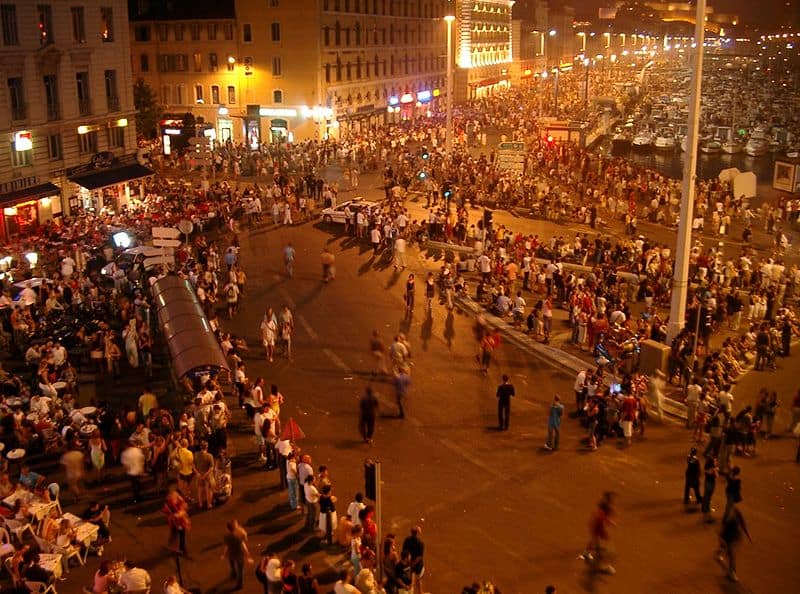
Buildup for Bastille Day fireworks Picture By Shane McGregor – Wikimedia Commons
Though the Eiffel Tower’s fireworks are the most famous, it does not mean that others in France are not worth it, on the contrary. Therefore, you could just as well hop at the top of Etretat’s gorgeous cliffs to see the fireworks illuminate the Chanel sea underneath. Annecy’s show is also reputed for playing on this reflective effect since it happens all around a lake. As to Cannes, it organizes a stunning pyrotechnic competition. But truth be told, I had the time of my life watching Bastille Day’s fireworks, surrounded by people as happy as I was, even in the smallest, most unknown cities in France.
Now that you know everything about Bastille Day, or rather, July 14th, pick your spot and enjoy the fireworks!
Planning a trip to Paris ? Get ready !
These are Amazon’s best-selling travel products that you may need for coming to Paris.
Bookstore
- The best travel book : Rick Steves – Paris 2023 – Learn more here
- Fodor’s Paris 2024 – Learn more here
Travel Gear
- Venture Pal Lightweight Backpack – Learn more here
- Samsonite Winfield 2 28″ Luggage – Learn more here
- Swig Savvy’s Stainless Steel Insulated Water Bottle – Learn more here
Check Amazon’s best-seller list for the most popular travel accessories. We sometimes read this list just to find out what new travel products people are buying.





